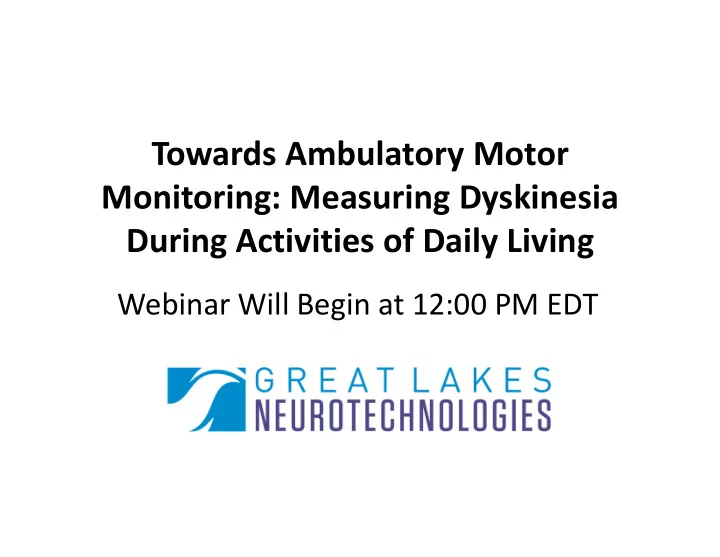

Towards Ambulatory Motor Monitoring: Measuring Dyskinesia During Activities of Daily Living Webinar Will Begin at 12:00 PM EDT
Outline • Motor Fluctuations and Levodopa-induced Dyskinesia • Challenges with Clinical Dyskinesia Assessment • Intelligent Algorithms for Continuous Monitoring of Dyskinesia
Fluctuations and Dyskinesia • Motor Fluctuations Chronic Stages of Levodopa Therapy – Alternate between “OFF” and “ON” states over dose cycle • Levodopa-induced Dyskinesia – Involuntary, episodic, and irregular movements Keijsers et al., Movement Disorders 18(1), 2003 – Most commonly occur at peak dose
Patient Impact https://www.youtube.com/watch?v=CaJymwziF-M
New Therapy Development
Clinical Assessment of Dyskinesia In-Clinic Assessment Patient Diaries • Rating scales only provide a • Self-assessment at home at temporal snapshot of dyskinesia regular intervals, confounded response, limited resolution by patient awareness, compliance
Technology-based Assessment Touch Motion Mobile Data Interfaces Sensors Networking Objective, high resolution Remote + measurement access
What exactly do motion sensors capture?
Tremor can be differentiated from voluntary motion by taking advantage of separation in the frequency spectrum
Arms Resting Same principles can be used to quantify dyskinesia when there is no voluntary motion Mera et al., Journal of Parkinson’s Disease 3(3), 2013
Quantifying dyskinesia during routine activities is significantly more challenging because of kinematic and spectral overlap
Motion Sensor Dyskinesia Quantification During ADLs • Motion sensor units positioned on hand, thigh, Motion and heel Sensor • Representative scripted ADLs performed over a 3-hr Cutting Food Drinking Dressing period after levodopa dose • Motion sensor data saved, videos scored by blinded Combing Hair Bagging Groceries raters using m-AIMS
Goals 1. Develop an intelligent algorithm that can rate dyskinesia severity across a range of routine activities 2. Determine a minimal set of motion sensors to minimize patient burden
Process Workflow Process Workflow • Patients perform tasks throughout dose Computational cycle, capturing range Model of severities
Process Workflow Process Workflow • Movement recorded by camera and Computational wireless motion Model sensors
Process Workflow Process Workflow • Blinded clinicians score dyskinesia using Computational modified AIMS scale Model
Process Workflow Process Workflow • Kinematic features extracted from motion Computational data using signal Model processing techniques
Process Workflow Process Workflow • Algorithms trained to predict dyskinesia Computational severity rating from Model kinematic feature(s)
Process Workflow Process Workflow • Process repeated using different Computational combinations of Model sensors and locations
Severity Scoring Model • Linear regression models were developed to predict total mAIMS score averaged across both raters using kinematic features as inputs
Hair Brushing Cutting Food Drinking from a Cup 4 4 4 R = 0.88 R = 0.91 R = 0.85 RMSE = 0.35 RMSE = 0.37 RMSE = 0.41 3 3 3 Model Score Model Score Model Score 2 2 2 1 1 1 0 0 0 0 1 2 3 4 0 1 2 3 4 0 1 2 3 4 Clinician Combined Average Score Clinician Combined Average Score Clinician Combined Average Score Bagging Groceries Dressing 4 4 R = 0.91 R = 0.89 RMSE = 0.37 RMSE = 0.39 3 3 Model Score Model Score 2 2 1 1 0 0 0 1 2 3 4 0 1 2 3 4 Clinician Combined Average Score Clinician Combined Average Score
Conclusions • A motion sensor system can accurately capture dyskinesia during routine activities – Provide an objective tool for quantifying motor symptom fluctuation in the context of daily life • Ongoing study to validate algorithms in ambulatory setting
Current Commercial Technology
Capturing Fluctuations AM
Pre-defined Tasks Discrete Points in Time In Front of Tablet PC Routine ADLs “Continuously” Anywhere
Upcoming Features • Moving towards system that can easily provide objective measures of medication state and physical mobility with minimal patient burden through continuous monitoring Medication State Physical Activity and Mobility
Acknowledgements Dustin Heldman, PhD Michelle Burack, MD, PhD Joseph Giuffrida, PhD E. Ray Dorsey, MD, MBA Thomas Mera, MS NIH/NINDS 7R43NS071882 NIH/NIA 9R44AG044293 Zoltan Mari, MD
Questions? Please contact: Christopher Pulliam, PhD Senior Biomedical Engineering Researcher cpulliam@glneurotech.com
Recommend
More recommend